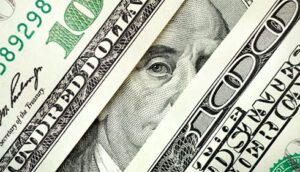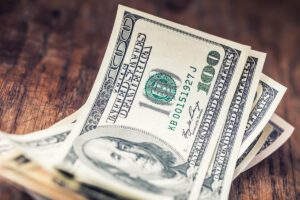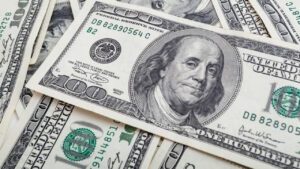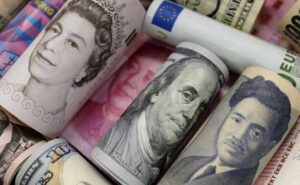
The U.S. dollar is getting cheaper against the euro, is stable against the British pound and rises against the Japanese yen in trading on Wednesday morning.
The ICE-calculated index showing the dollar’s dynamics against six currencies (euro, Swiss franc, yen, Canadian dollar, pound sterling and Swedish krona) is losing 0.13%, while the broader WSJ Dollar is down 0.03%.
The focus for traders this week is the minutes of the Federal Reserve’s November 1-2 meeting, at which the U.S. central bank raised its benchmark interest rate by 75 basis points (bps) and hinted at the possibility of a slowdown in its rate hike.
The minutes of the meeting will be published on Wednesday at 9 p.m. The experts expect the report to show that the Fed’s leaders reached a consensus on the need to slow the rate hike, Bloomberg wrote. However, there’s no consensus among them as to what interest rate cap will start to slow economic activity and lower the rate of inflation.
The euro/dollar pair is trading at $1.0329 as of 8:30 Moscow time, down from $1.0306 at the close of the previous session.
The dollar rose to 141.34 yen in trading against 141.22 yen on Tuesday.
The pound exchange rate was stable at the level of $1.1887 at the close of the previous session.
Meanwhile, the Chinese yuan was falling 0.19% against the dollar to settle at 7.1541 yuan per $1 as of 8:40 Moscow time. Investors are worried about new lockdowns in major Chinese cities because of a new outbreak of the coronavirus in the country which may trigger a slowdown in economic growth.

The US dollar is getting cheaper against the euro, the yen and the pound sterling in trading on Tuesday after the previous session’s strengthening following another Federal Reserve (Fed) statement.
This week, traders will focus on the Federal Reserve’s minutes of November 1-2 meeting at which the U.S. central bank raised its benchmark interest rate by 75 basis points (bps) and hinted at a possible slowdown in the rate hike.
The minutes of the meeting will be released Wednesday at 9 p.m. ET.
On Monday, Federal Reserve Bank (FRB) presidents Loretta Mester and Mary Daly of Cleveland and San Francisco signaled that the U.S. central bank would slow the pace of prime rate hikes next month, while stressing that the need for further policy tightening remains.
“I believe we can slow down the rate hike at the next meeting, I don’t see a problem with that,” Mester told CNBC. – However, I don’t think we’re close to pausing.”
For her part, Daley said the Fed should be mindful of the time lag between Fed decisions and their impact on the real economy. At the same time, she reiterated that she sees the need to raise the rate to at least 5%.
The ICE-calculated index showing the dollar’s performance against six currencies (euro, Swiss franc, yen, Canadian dollar, pound sterling and Swedish krona) lost 0.18% on Tuesday, while the broader WSJ Dollar lost 0.17%.
The euro/dollar pair is trading at $1.0259 as of 8:15 a.m., up from $1.0243 at the close of the previous session.
The dollar traded down to 141.78 yen from 142.14 yen on Monday.
The pound rate rose to $1.1851 compared to $1.1824 the day before.

The dollar is moderately depreciating against the euro and appreciating against the yen on Wednesday morning as investors assess geopolitical risks and U.S. inflation data.
The ICE-calculated index, which shows the U.S. dollar’s performance against six currencies (euro, Swiss franc, yen, Canadian dollar, pound sterling and Swedish krona), is up less than 0.1%, as is the broader WSJ Dollar Index.
The day before, the dollar index had fallen to a three-month low on further signals of slowing U.S. inflation.
As it became known on Tuesday, producer prices in the United States (PPI) rose 8 percent year-over-year in October and 0.2 percent against September. Analysts polled by Trading Economics forecasted an average increase of 8.3% for the former index and 0.4% for the latter.
Meanwhile, Rafael Bostic, head of the Federal Reserve Bank (FRB) in Atlanta, expressed the view that the Fed should continue to raise interest rates until there are signs of widespread easing in inflation. “We haven’t seen that yet, so I believe we will need new rate hikes,” Bostick wrote. He added, however, that he sees “glimmers of hope” in the past three months, but prices are falling mostly for goods, not services.
The currency market is also reacting to news of a rocket explosion in Poland, which killed two people. A number of media outlets wrote that the missile could have come from Russian territory.
However, Polish President Andrzej Duda said the government could not yet confirm who fired the missile, and U.S. President Joe Biden said it was unlikely that it came from Russian territory.
The Russian Defense Ministry denied that the rockets were Russian, saying that the military had not struck any targets near the Ukrainian-Polish border.
The euro/dollar pair was trading at $1.0370 by 7:52 a.m., versus $1.0350 at the close of Tuesday’s session, with the euro strengthening 0.2%.
The dollar/yen is up 0.4% at 139.82 yen, up from 139.31 yen at the end of last session.
The pound is stable and trading at $1.1865.

The dollar is weakening against the euro and is recovering against the yen after a sharp drop against almost all world currencies the day before, triggered by data on a significant weakening of inflation in the United States.
As it became known on Thursday, consumer prices (CPI) in the United States rose by 7.7% in October against the same month last year after an increase of 8.2% in September. Thus, inflation slowed to its lowest since January and was well below market forecasts.
The data may affect the policy of the U.S. Federal Reserve (Fed), which is aggressively raising interest rates in an attempt to curb inflation.
The head of the Federal Reserve Bank (FRB) of Philadelphia, Patrick Harker, already spoke in favor of slowing further rate hikes.
“In the coming months, in light of the cumulative tightening (of QE – IF) already achieved, I expect the pace of rate hikes to slow down as we get closer to sufficiently restrictive policy,” Harker said during a speech at an event in Philadelphia.
The ICE-calculated index, which shows the U.S. dollar’s performance against six currencies (euro, Swiss franc, yen, Canadian dollar, pound sterling and Swedish krona), is down 0.25 percent. The day before, the indicator was down 2%.
The euro/dollar pair is trading at $1.0218 by 7:55 a.m. Ksk, versus $1.0209 at the close of Thursday’s session, with the euro strengthening 0.1%.
The dollar/yen is up 0.4% at 141.57 yen, up from 140.97 yen at the end of last session.
The pound is changing little and is trading at $1.1716 compared to $1.1715 at the close of previous trading.
The mainland yuan rose 1.1 percent to 7.1089 yuan per $1, renewing a four-week high.
The Australian dollar is up 0.5 percent at a seven-week high of $0.67, despite statements by Australia’s Deputy Central Bank Governor Michelle Bullock that the country’s interest rate is likely to continue rising.

Traders are waiting for inflation data in the U.S. for October, which will be released by the U.S. Labor Department on Thursday at 15:30.
Experts polled by Trading Economics forecast on average a slowdown in consumer price growth in the country to 8% year on year from 8.2% in September.
The U.S. inflation report for October is likely to be a key factor in determining how much the Federal Reserve (Fed) will raise rates at its December meeting.
The market is currently pricing in a 50 basis point (bps) rate hike in December, but a higher-than-expected October inflation rate could shift those expectations in favor of another 75 bps increase, Trading Economics notes.
The ICE-calculated index showing the dynamics of the dollar against six currencies (euro, Swiss franc, yen, Canadian dollar, pound sterling and Swedish krona) is adding 0.28%, while the broader WSJ Dollar is adding 0.33%.
The euro/dollar pair is trading at $0.9950 as of 3:30 p.m. MSC, compared to $1.0014 at market close on Wednesday.
The European Central Bank (ECB) on Thursday took steps to address a shortage of highly liquid government bonds on the market, which are used as collateral in market transactions. The problem has become urgent as the ECB has been buying bonds for years in a row as part of its quantitative easing program.
On Thursday, the ECB decided to increase to 250 billion euros from 150 billion euros the limit for securities lending to financial institutions against cash collateral, said Isabel Schnabel, a member of the ECB’s executive board.
“This is a precautionary measure to alleviate the shortage of securities collateral in the market and keep it functioning at the end of the year,” she wrote on Twitter.
The U.S. currency is at 146.47 yen versus 146.41 yen in the previous session. The pound rose to $1.1392 from $1.1357 the day before.
The dollar/yuan pair is trading at 7.2535 yuan against 7.2419 yuan at the close of the previous session.

The U.S. dollar is strengthening against the euro, yen and pound sterling in trading Tuesday.
The ICE-calculated index showing the dollar’s dynamics against six currencies (euro, Swiss franc, yen, Canadian dollar, pound sterling and Swedish krona) is adding 0.22%, while the broader WSJ Dollar is up 0.14%.
The euro/dollar pair is trading at $1.0007 as of 8:15 a.m., compared with $1.0022 at Monday’s market close.
The U.S. currency rose to 146.67 yen from 146.61 yen in the previous session.
The pound exchange rate fell to $1.1491 from $1.1514 the day before.
Traders’ attention this week is focused on the inflation data in the U.S. for October, which will be published by the Labor Department of the country on Thursday. Experts polled by FactSet are predicting, on average, a slowdown in U.S. consumer price growth to 8 percent year-over-year, down from 8.2 percent in September.
October U.S. inflation data will likely be a key factor in determining how much the Federal Reserve (Fed) will raise the benchmark rate at its December meeting.
Last Wednesday, the Fed raised rates by 75 basis points (bps) for the fourth consecutive meeting, to 3.75-4% per year, the highest since January 2008. U.S. Central Bank Chairman Jerome Powell said that the Fed could begin discussing a slowdown in the rate hike as early as the December meeting. At the same time, he stressed that it was too early to talk about stopping the cycle of rate hikes, and its limit will be higher than previously expected.
President of the Federal Reserve Bank (FRB) of Boston Susan Collins, speaking at the Brookings Institution, said that in December the Fed will discuss the possibility of another rate hike of 75 bps, as well as its less significant increase – 50 bps.